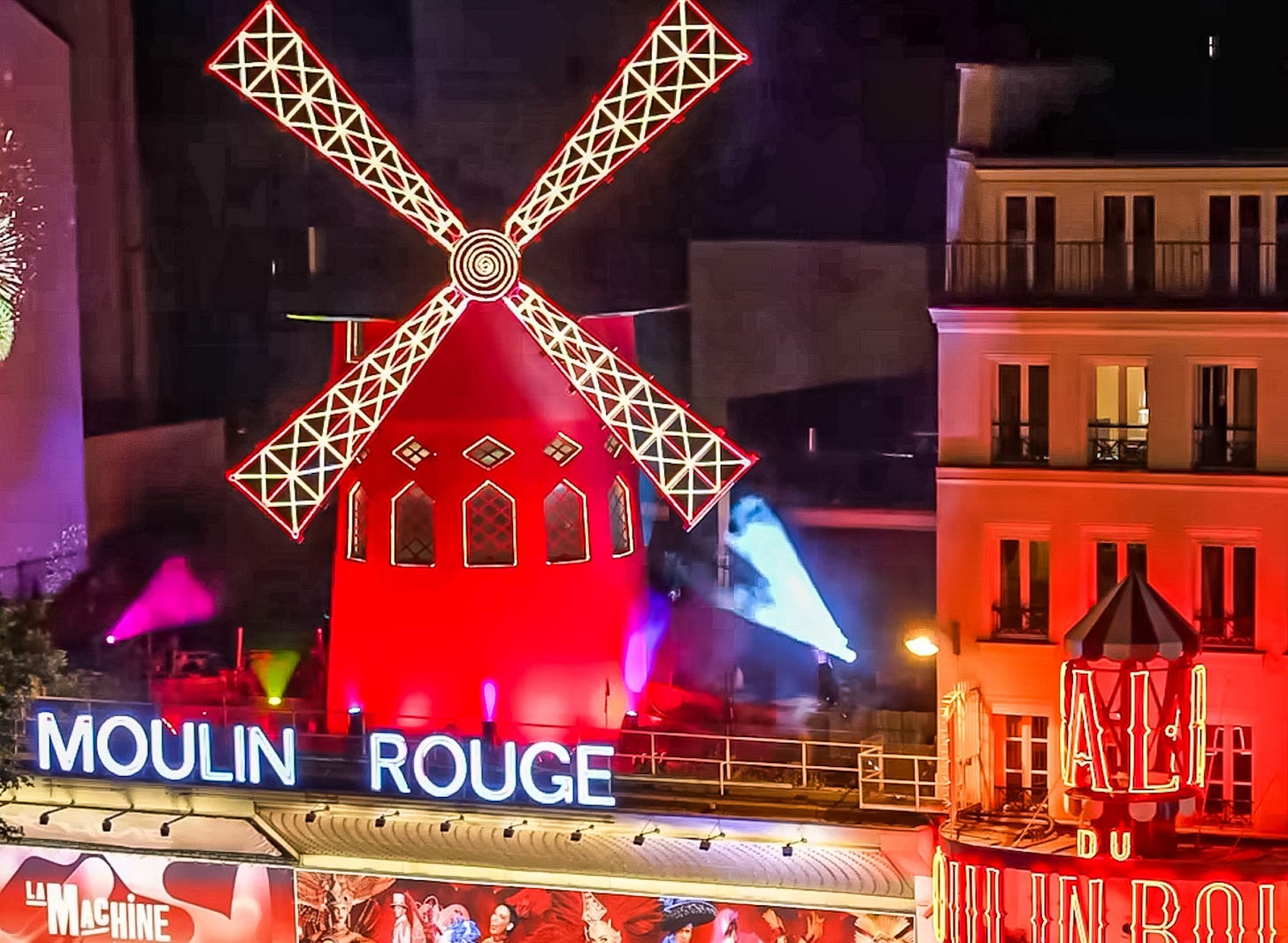On This Day in 1889, Moulin Rouge Opened and Paris Would Never Be the Same
The night a red windmill turned the rules of society, art and pleasure upside down
I’ve been away from this blog for a few weeks. Life interrupted, as it often does. But today’s date demands attention. On this day, 6 October 1889, the Moulin Rouge opened its doors in Montmartre. Half-finished, loud, and unapologetic, it changed Paris in a single night. This was not a theatre in the traditional sense. It was a spark. What happened there was not elegance, it was explosion.
Cabaret Without a Script
The first impression was chaos. A strange building with a red windmill stuck on top and a stucco elephant outside that some said hid an opium den. This was not Haussmann’s tidy Paris. This was Montmartre, wild and working class, where rules were optional and the wine was cheap.
Inside, rich men in silk cravats sat beside painters with only a few coins to their name. Champagne flowed, but so did cheap house wine. Status meant little. What mattered was your view of the stage.
The orchestra struck up and the first performance began. No one in the crowd knew what to expect. What they got was something new. The Moulin Rouge was not just entertainment. It was shared shock. A moment where people from different worlds looked at the same scene and laughed, gasped, or applauded together.
The young artist in the crowd that night may not have had money, but he had a seat, and that meant he had access. That was the spirit of the Moulin Rouge from the beginning. If you could get through the doors, you were in.
Can-Can Girls and Crowned Heads
One year later, the ballroom was complete and the energy even more dangerous. That was the night Louise Weber, known to everyone as La Goulue, danced for Edward, Prince of Wales.
She drank wine from a stranger’s table, cartwheeled across the floor, and shouted at the future King of England to pay for the champagne. The crowd roared. No one pulled her off stage. No one told her to behave. She was the star, and in the Moulin Rouge, the star ran the room.
What happened that night was not just performance. It was inversion. A woman from working class Paris had the prince laughing like a boy in the front row. That sort of moment was impossible at court, but here, it was expected.
The Moulin Rouge allowed it, even encouraged it. It was a space where social roles bent to the force of charisma and courage. La Goulue had both.
The prince left smiling, and his approval sealed the club’s reputation. Not because the club had changed, but because royalty had bowed to its world, even if only for one night.
Scandal as Spectacle
By 1907, the shows had grown more elaborate and more controversial. That year, a performance involving two women, Matilde de Morny and Colette, ended in a kiss on stage. The crowd erupted, not in applause, but protest.
Old men in stiff coats booed and threw vegetables. Police had to break up the violence. The next night, the show returned with a male actor in Matilde’s role, but the point had already been made.
The Moulin Rouge had pushed too far for some. Good. Art should test limits. And the limits being tested here were not just about gender or sex. They were about freedom. The freedom to act, to express, to perform without seeking permission.
Those who were offended shouted. Those who believed in it stood their ground. That fight played out in full view. It was not staged. It was real. And it was part of the show.
Fire, Ash and the Return
In 1915, fire destroyed the Moulin Rouge. Flames ripped through the building, reducing the famous cabaret hall to rubble. Only the red windmill survived, blackened by smoke.
For most venues, that would have been the end. But the Moulin Rouge had never relied on walls. Its power came from its story.
In 1921, it reopened. Rebuilt, reimagined, but not tamed. It attracted performers and crowds from across the world. Its influence spread far beyond Montmartre. Paintings, films and musicals carried its image into the next century.
Yet at its core, the same spark remained. It did not ask permission to exist. It still offered a stage to those who did not belong anywhere else.
Why It Still Matters
It is tempting to treat the Moulin Rouge as a symbol of glamour. But glamour was only the surface. What lived beneath was defiance.
It gave a platform to the overlooked and the provocative. It embraced artists, dancers and outsiders. It welcomed the poor and the powerful without judgement. And when controversy came, it stood in the centre and kept the music playing.
That matters. In a world that continues to divide people by wealth, by background, by conformity, places like the Moulin Rouge remind us that rules are made by people, and people can choose to break them.
On this day in 1889, a red windmill turned in Paris for the first time. It spun through scandal, fire, protest and applause. And somehow, it kept going.
That is not nostalgia. That is legacy.



Superb piece of writing ✍️
By Eddie Gibbs pal of the King 🤴
One day I hope to be as talented ✨️
And similarly complimented
Keep up the great work buddy
From your upcoming prodigy 😉